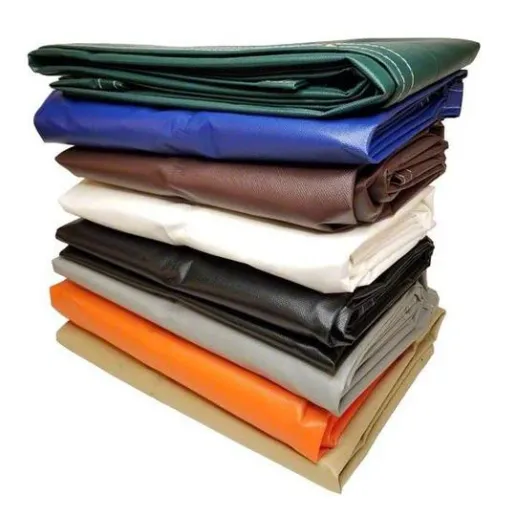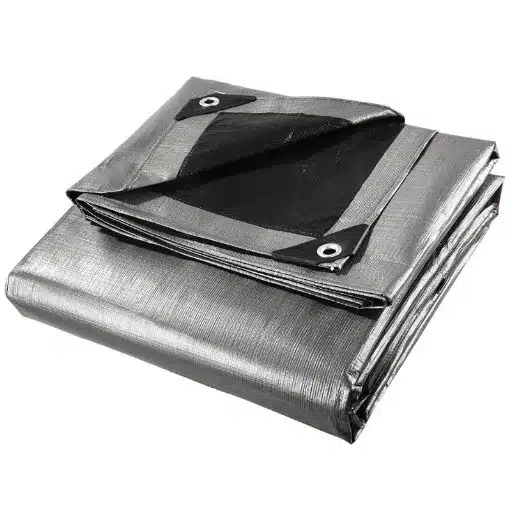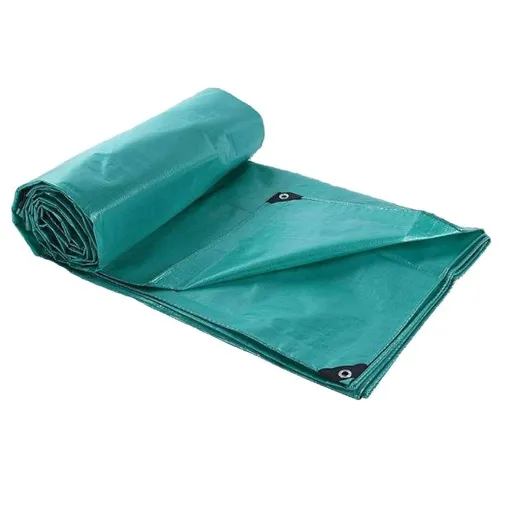When it comes to shielding your valuables from the weather, the right tarp matters a lot. Be it outdoor furniture, a vehicle, or prepping for a storm, the right waterproof tarp is vital. Such a tarp has to be suited for your needs. What tarp provides the best protection when it comes to so many features, designs, and materials? This article will explain to you the features that make a tarp waterproof, examine the trustworthy options available, and help you decide what works best for you. Prepare to uncover the solution for protecting yourself and your valuables!
Understanding Tarp Materials
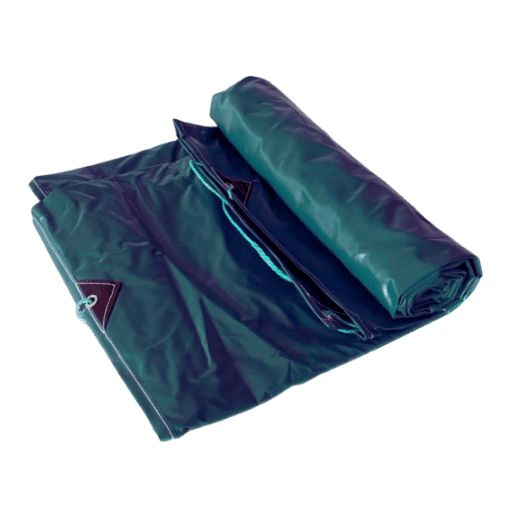
Types of Tarps: A Quick Guide
Knowing each tarp type helps ensure you pick the right one for the task. Tarps are typically distinguished based on their materials, thickness, and the purpose for which they were designed. Below are some of the most popular ones:
Polyethylene Tarps
These tarps are strong and waterproof. They are constructed from woven polyethylene, which is then covered using a poly film. They serve well for heavy-duty uses, such as covering machinery or forming shelters for temporary use.
Canvas Tarps
Canvas tarps are made from natural materials that allow for ventilation, making them suitable for construction material protection. They provide some protection from water but are not as water-proof as other tarps. Hence, they work well in places where moisture is not a major threat.
Vinyl Tarps
These tarps are strong and completely waterproof, making them ideal for industrial or professional use. They can be subjected to extreme temperatures and are tear, oil, and chemical resistant.
Mesh Tarps
Requiring airflow landscapers, dump trucks, and pool covers use mesh tarps. They are light in weight and allow wind and water to pass through easily.
Specialty Tarps
Specialty tarps include fire-retardant tarps, UV-resistant tarps, and tarps made for specific purposes like truck covers, hay protection, and even sports fields.
💡 Pro Tip: It is essential to evaluate each option against your specific needs. For example, a vinyl tarp may be the best choice in extreme conditions, while a mesh tarp is best in windy conditions. The most searched for tarp, heavy-duty polyethylene tarps, offer multi-purpose uses and are inexpensive, which is why they keep selling.
Canvas Tarps: Strength and Durability
Canvas tarps specialize in strength, durability, and eco-friendly features, which makes them the ideal choice for both industrial and domestic use. As tightly woven cotton or polyester fabric, they undergo less strain during extreme wear as compared to other materials while maintaining breathability. Drawing from the latest data available from search engine, interest in canvas tarps appears to be growing steadily due to the public’s knowledge of their ability to sustain heavy-duty use coupled with reusability, appealing to green-minded consumers. A great number of users are looking for canvas tarps to replace synthetic materials, especially for uses requiring a natural breathable solution, such as covering equipment that is susceptible to moisture buildup. For all of these reasons, canvas tarps continue to be seriously considered for use, especially among professionals who take strength, longevity, and sustainability seriously when it comes to tarp choice.
Polyethylene Tarps: Lightweight and Versatile
Polyethylene tarps are some of the most flexible and widely utilized tarps available today. These tarps are commonly used for various other purposes because of their lightweight construction. Polyethylene tarps are made from a woven polyethylene blend, which is then coated in a blend of polyethylene film, making the entire product highly resistant to tearing, water, and UV rays. Looking at search engine data from today, one of the most Googled questions in relation to polyethylene tarps is, “What is the ideal use for polyethylene tarps?” This question has an obvious answer; their usage is very versatile and includes safeguarding construction materials, making shelters, and even covering outdoor furniture and machinery. The reason behind their widespread use is their low prices and the availability of many different sizes and thicknesses, which makes them suitable for both homeowner and business use.
Waterproof vs. Water-Resistant Tarps
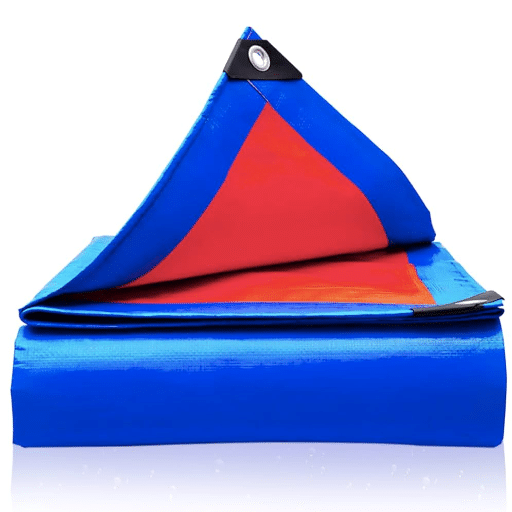
Defining Waterproof And Water-Resistant
| Feature | Waterproof Tarps | Water-Resistant Tarps |
|---|---|---|
| Water Protection | Complete moisture barrier, maintains total dryness even during intense downpours | Some resistance, may leak in prolonged heavy downpour |
| Materials | Polyethylene, vinyl with complete moisture barrier | Water-shedding materials but not fully impermeable |
| Breathability | Limited breathability | More breathable, better ventilation |
| Best Use | Protective needs under wet conditions | Areas where minimal water protection is sufficient |
The decision to use either waterproof or water-resistant tarps is often informed by the specific requirements of use. For protective needs under wet conditions, waterproof tarps are best. While water-resistant tarps may be more breathable, they offer minimal protection against water. Search terms such as “waterproof tarps for camping” and “durable water-resistant tarps” have recently increased, indicating a greater focus on specific use products for the outdoors.
Identifying the Best Waterproof Tarps
Selecting the best waterproof tarps requires careful consideration of the material, durability, size, and purpose of the tarp. Recent search trend data shows that users are interested in tarps made from polyethylene and PVC. This is likely due to the fact that both polyethylene and PVC tarps are well known for their superior waterproofing and strong construction. PE tarps are cheap and lightweight and therefore perfect for short term use. PVC tarps, on the other hand, are best for long term and heavy-duty use, such as construction. As users search for ‘heavy-duty waterproof camping tarps,’ the need for light, high-performance tarps becomes apparent. The use, such as camping, covering of machinery, or sheltering, will determine the best selection.
Advantages Of Water-Resistant Tarps
The water resistant tarps have various uses and advantages that can be appreciated across various industries. The recent data from search engine indicates that users frequently ask for weather resistant tarps that are lightweight and sturdy. For one, water-resistant tarps help shield camping gear, tools, and outdoor furniture from rain, moisture, and mildew, thereby safeguarding the items for long periods. In addition, such tarps, especially in their advanced forms, are crafted to be both tear resistant and weather resistant, and as such, they are suitable for both domestic and industrial applications. Their widespread usage is further enhanced by their versatility, ease of transport, and low price, all of which are supported by the growing global demand revealed by search analytics. Whether you need dependable coverage for a small backyard renovation or heavy-duty protection on a construction site, water-resistant tarps offer a viable and inexpensive alternative.
Key Features of Waterproof Tarps
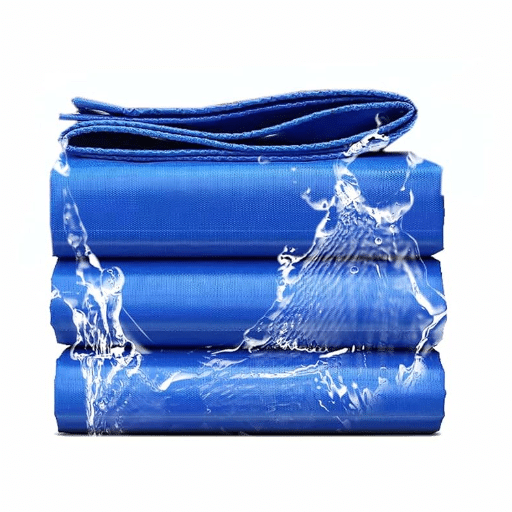
The Thickness of the Tarp and Why It Matters
The thickness of the tarp matters in its construction and intended use. The sturdier a tarp is, the thicker it is, and it tends to be more durable against construction wear and tear, making it suitable for construction, truck coverage, and prolonged outdoor use. On the other hand, thin tarps are malleable and lighter in weight, making them fitting for gardening, camping, and temporary tents.
📊 Thickness Guidelines:
- 5-10 mils: Light-duty uses (gardening, temporary coverage)
- 10-20 mils: Most preferred for outdoor rugged uses
- 20+ mils: Heavy-duty construction and industrial applications
Recent analytics from search engine suggest a rising concern for the correct tarp thickness in different scenarios. Searches like “What is the best tarp thickness for outdoor use?” or “Heavy-duty tarp durability” have exponentially risen, signifying that customers are more concerned with sturdiness and functionality. For most outdoor rugged uses, tarps within the 10-20 mils range are most preferred, whereas tarps within 5-10 mils are adequate for light-duty tarp uses. Matching a tarp with an intended task ensures a greater chance of accomplishing the task with greater ease and a more lasting outcome.
UV Resistance and Life Span
UV resistance has a huge impact on tarp life span, particularly in the case of outdoor tarps that are constantly exposed to sunlight. The data collected from search engine shows that the terms “UV resistant tarps” and “long lasting tarps for outdoor use” are now very popular. This shows the concern of the users in getting materials that can withstand sunlight as a form of wearing over time. The high quality tarps that have been treated with UV inhibitors can resist the damage that comes from ultraviolet radiation, and as a result, can last for much longer. In order to get the best performance, choosing tarps that have an explicit UV resistance specification guarantee that the tarps can maintain the strength, flexibility, and protective qualities even after exposure over a very long period of time to sunlight.
Tear Prevention Methods
A synergistic approach towards maintenance, the right materials, and appropriate usage goes a long way in preventing tarps from tearing. Data and recent search trends show that a lot of people look for strong tarps enhanced with rip-stop fabrics or certain woven fabrics that help control the growth of rips. The threat of tearing can be greatly minimized if the tarps are properly secured using evenly spaced grommets and a complete lack of sudden jerks or sharp edges. Immediate covering of minor damages with repair patches or tapes also ensures the tear will not be made worse. To tackle the problem in the long run, protective cure of the tarp with cool and dry storage during its off seasons goes a long way in preserving the material for future use, guaranteeing the tarp will be more dependable for an extended period of time.
Choosing the Right Tarp for Your Needs
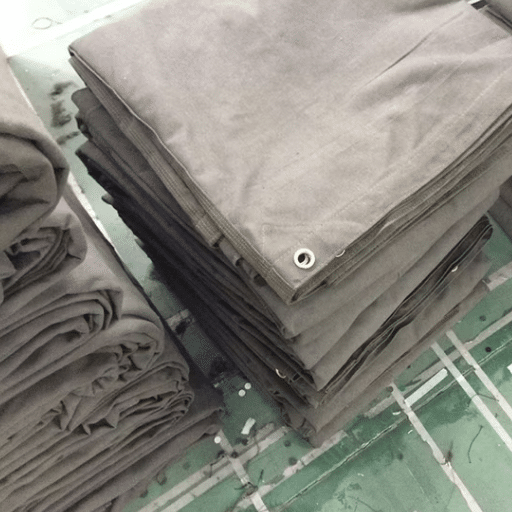
Application Scenarios for Tarps
Tarps have a vast array of applications in various fields. As the primary use of tarps is in construction, there, as well as other branches, their functions are well known. In construction, tarps offer protection from harvest machinery and consumables, as well as procurements and materials. They protect them from the sun, wind, and rain. Farmers also use tarps to protect their machinery or hay during harvesting and for consumable cover. They are also essential for campers, as tarps serve as shelter or ground cover as well as makeshift rainflys. The transportation sector also makes use of tarps to cover merchandise on trucks, ensuring proper shipment of the merchandise. With the help of bucket trucks, homeowners use tarps to cover furniture or floors. In general, tarps offer protection and durability and are essential assets for various applications.
Factors to Consider When Choosing a Tarp
The first step in choosing tarps is to take note of the features that are essential in fulfilling the specific purpose. As tarp materials can either be canvas, vinyl, or polyethylene, the type of material should be the first to be sought after. General use tarps made of polyethylene are effective in being lightweight, cost-effective, and waterproof. For long-term use tarps, canvas is often demanded because of the additional breathability and strength it offers in comparison to other materials. For strong use, deck tarps are made of vinyl, as it is also strong and weather proof.
The required tapes’ length and width, as well as thickness (mil measurement), tarps, along with apposite tear resistance, UV protection, and other environmental factors, must also consider the maintenance environment that the tarps will be exposed to. Tarps made of high quality material with reinforced and elastic grommet edges are customizable and can handle overexposure to sunlight. Thin tarps are suited for light loadout work, while for outdoor use tarps are required to be thicker. Additionally, for strip decking and fabric tears, UV protection and other rugged environmental resistors need to be considered.
Think about the intended use and the prevailing weather conditions. If heavy rain or snow is in the forecast, reinforced, sealed-seam waterproof tarps are necessary. choose tarps that reduce the chances of being displaced in regions that are windy. Choose tarps that have sturdy anchoring points as to withstand winds. With specific knowledge of your needs, gather the latest information on tarps and customer reviews so as to select the correct tarp for the project.
Tips for Selecting Heavy Duty Tarps
While choosing the heavy duty tarps for your needs, the latest insights and trends data would certainly help. Here is a brief explanation of the considerations based on the recent search insights.
🔧 Material Durability
Polyethylene and vinyl tarps are most searched and recommended for heavy-duty tarps due to their durability. Vinyl tarps outperform other tarps in industrial or high-stress environments.
☀️ UV Resistance
UV resistance of heavy tarps is the most searched and highly ranked in tarps used for prolonged exposure to direct sunlight. Coatings of UV treatments and other products are increasing in demand.
💧 Waterproofing
There is a steady rise in searches of waterproof tarps which are an indication of increasing demand for dependable weather protection solutions. For wet climates, the tarp must be fully waterproof, hence check the ratings of the tarp that you choose.
🔗 Reinforced Edges and Grommets
Search data for trends such as edges of tarps reinforced, double or triple sewing, and rust proof grommets indicate a preference for these tarps over others. These features provide the tarp with improved functionality and longer life.
📏 Size Customization
Query volumes related to “custom size tarps” indicate increased demand for these solutions. Check the manufacturers for offering custom sizes tarps to meet your specific needs.
By aligning the above insights into the latest trends with your personal requirements, you can identify a tarp that meets durability and functionality needs while keeping you updated with the advancements in the market.
Maintaining Your Waterproof Tarp
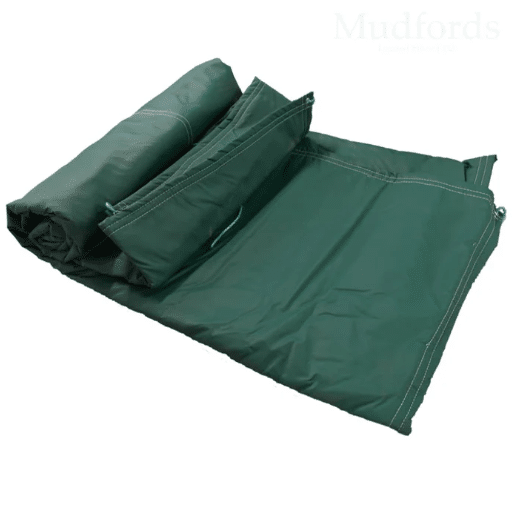
Proper Tarp Cleaning and Storage Practices
To properly clean and store a tarp, begin by removing any visible dirt or debris using a brush or a slightly damp cloth. For a fuller clean, mild soap diluted in water is the best solution, but the tarp should be gently scrubbed to avoid material damage. If dirt is stubborn, rinse it multiple times with plain water to fully remove all the soap. Soap residue, especially when left over a period of time, can cause the tarp’s waterproofing to degrade. A misconception especially in the modern age of search engines data collection is the frequency of users searching “best cleaning products for tarps.” While a neutral pH detergent is the best, it is neutral pH detergents that are universally the best, as they are both effective and gentle to the tarp material.
⚠️ Storage Warning: After cleaning, make sure the tarp is completely dry before folding to prevent mold and mildew development. Store it folded in a cool dry place away from sunlight to help maintain the tarp’s strength. Notably, there has been a rise in searches related to “compact storage solutions for tarps,” indicating that ‘lightweight storage bags for tarps’ are becoming popular for their ease of use and the protection they offer. These steps not only help preserve your tarp but ensure that it will be ready for use when it’s needed again at peak condition.
Your Tarp’s Useful Life Optimisation
There are several ways in which you can improve the life of your tarp, combining the proper maintenance of your tarp and information found in search engine data can help a great deal. Generally, the question “what is the best way to prevent tarp damage whilst in use or in storage?” is the most asked. As has been noted, the use of lightweight, weatherproof, eco-friendly products that help with wear and tear has gained a great deal of focus in search enterprises.
With the use of durable, rust resistant grommets and anchors, securing your tarp firmly aids greatly in its use and protection from damage, completing this step goes a great deal in after the inverted Sieg Telescopic Batten Swage. There also has been an increase in the search “UV resistant tarps” signifying the need for tarps of higher quality to aid in the use of protection from the sun and tarps degradation. Proper balance folding in a mildew preventing breathable storage bag for the tarp is also a positive. As has been noted the increased concern with looking for sustainable options there are tarps that are recyclable and tarps that are biodegradable that can also aid in the concern, and help with the conserveness for the future for rent.
Implementing these practices, addressing the outlined concerns, and following best methods will help keep the tarp in great condition while considering the modern trends of quality, ease of use, and sustainability.
Maximizing Waterproof Features
Proper maintaining paired with material choice is very important for the dried tarp to retain its waterproof features. From the latest search data of the search engine, users have constantly wanted to know the effectiveness and the durability of water resistant coatings. Water resistance is more guaranteed if the tarp is made of high density polyethylene (HDPE) or PVC. Once the protective layer is weak especially due to some strong weather, waterproofing sprays and sealants after being applied will be very helpful in restoring the protective layer. Water pooling is also a very damaging factor and can also weaken the waterproof features modestly over time. Ensuring that the tarp is properly stretched and securing the tarp during use is another effective preventative measure. After all these measures, the tarp remains a reliable shield for moisture and the destruction it causes and its life is also extended.
❓ Frequently Asked Questions
🔧 Which waterproof tarp is best for poly, vinyl, or heavy duty tarp use?
Poly and vinyl tarps, along with heavy duty poly tarps, offer excellent waterproof capabilities and durability. They are suitable for heavy duty applications. Such tarps can be relied on for covering and protecting outdoor items, as they withstand strong weather and moisture. Looking at the mil thickness of the tarp is advisable since these are related to the degree of wear and tear resistance a tarp has. Tarps with reinforced edges and grommets for securing the tarp are of added advantage.
📏 In what way does the thickness of a tarp influence its waterproofing?
As you can imagine, the thinner the tarp, the less waterproof it is. This is why tarp thickness is critical in determining its waterproofing ability. A 10 mil tarp, for example, is more waterproof and durable than a 6 mil tarp. Keep in mind, however, the weight of the tarp as well; they tend to be heavier and thicker as well. A tarp of waterproof quality—regardless of its type, whether it’s made of canvas, poly, or vinyl—will keep your stuff safe and dry, even in heavy rain or snow.
🏕️ Are waterproof canvas tarps useful for outdoor activities?
Indeed, canvas tarps are effective outdoors, especially when some form of ventilation is required. This is because tarps are made out of rugged canvas, which has undergone special treatment to improve its water-repellent characteristics. Even though canvas tarps are not fully waterproof, the water resistance they provide, coupled with their ruggedness, makes them much sought after for protecting outdoor items. For covering broader areas, there are bigger tarps, and smaller ones are also available for more precise needs. Also, check the weight and thickness of the canvas tarp for better performance.
💪 What features are important to look for in a heavy duty tarp?
When selecting a heavy duty tarp, ensure it is sturdy, waterproof, and durable. The features to consider are tarp material, reinforced edges, and thickness measured in mils. Poly and vinyl are considered heavy-duty waterproof tarp materials and can withstand tough weather. Vinyl and poly tarps are heavy duty waterproof tarps and are made from tough weather materials. Additionally, flapping in windy conditions can be minimized if the tarp is secured and tied down with vinyl or poly tarp grommets, which also provide easier securing. Tarps are also required to be UV resistant, which you should check if it’s included as part of the tarp materials.
🏠 What do waterproof tarps offer in the way of outdoor and indoor protection?
Waterproof tarps are useful in both indoor and outdoor protection. The tender keeps your items dry during any kind of precipitation, including rain and snow, which is an advantage. Using waterproof tarps of any kind is crucial in camping, construction, and storage operations. Additionally, the tarps are useful in covering vehicles, boats, and even outdoor furniture. Moreover, using light weight tarps is a plus as they are easy to carry and set up, and at the same time, heavy duty tarps are also available for more intense protection needs.
📚 Reference Sources
- U.S. Environmental Protection Agency (EPA): Discusses impermeable materials, including plastic sheeting, which can be relevant for understanding waterproofing standards.Link to source
- University of California Agriculture and Natural Resources (UCANR): Provides insights into the use of tarps for weed control and other agricultural applications, including material recommendations.Link to source
- CROSS Ruling by U.S. Customs and Border Protection: Offers detailed classifications and descriptions of polyethylene tarps, including their waterproof and UV-resistant properties.Link to source

